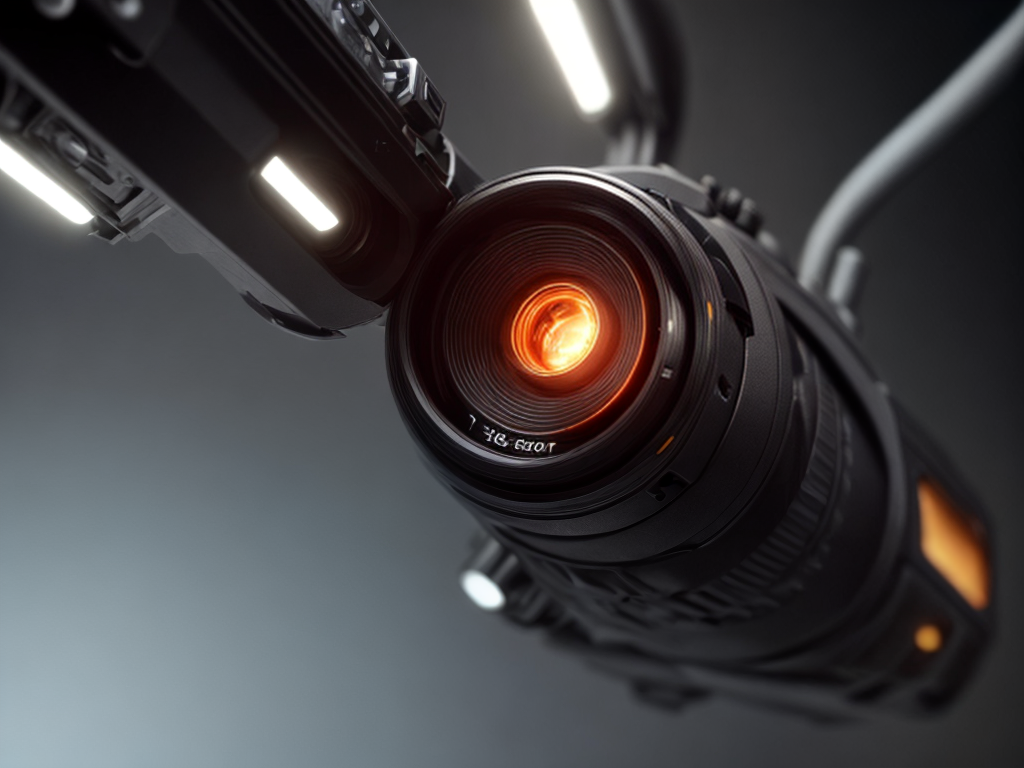
As a technology enthusiast, I am fascinated by the incredible capabilities of optical sensors. They are like the eyes of modern systems, perceiving the world in a way that surpasses human vision. In this article, we will explore the principles, types, and real-world implementations of optical sensors. From understanding light properties to delving into photodiodes and phototransistors, we will uncover how these sensors revolutionize industries like automotive and healthcare.
Get ready to dive into the fascinating world of optical sensors!
The Basics of Optical Sensors
In this article, I will explain the basics of optical sensors. Optical sensors are devices that use light to detect and measure physical properties such as position, distance, motion, and presence. They rely on the principles of reflection, absorption, transmission, and emission of light to gather data. Over the years, optical sensor technology advancements have significantly improved their accuracy, sensitivity, and reliability.
Today, optical sensors are widely used in various industries, including automotive, aerospace, medical, and consumer electronics. They offer advantages such as non-contact measurement, high-speed operation, and immunity to electromagnetic interference. Optical sensors can be found in applications such as object detection, gesture recognition, biometric authentication, and environmental monitoring.
With ongoing research and development, we can expect further advancements in optical sensor technology, enabling even more sophisticated and efficient systems.
Understanding Light and Its Properties
As an optical sensor enthusiast, I find it crucial to understand the fundamental properties of light. Light behaves as electromagnetic waves, carrying energy and information. Understanding the mechanisms of reflection and refraction is essential in comprehending how light interacts with different materials, enabling the design and implementation of effective optical sensors.
Light as Electromagnetic Waves
Light is a form of electromagnetic waves that possess unique properties and plays a crucial role in the functioning of optical sensors. Here are some key points to understand about light as electromagnetic waves:
- Electromagnetic Spectrum: Light is just a small portion of the electromagnetic spectrum, which also includes radio waves, microwaves, infrared, ultraviolet, X-rays, and gamma rays. Each type of wave has different properties and applications.
- Wave-Particle Duality: Light exhibits both wave-like and particle-like properties. It can behave as a wave, with characteristics like wavelength and frequency, and as a particle called a photon, with discrete energy levels.
- Speed of Light: Light travels at a constant speed of approximately 299,792 kilometers per second in a vacuum. This property allows for the precise measurement of distances and the transmission of information through optical fibers.
- Interaction with Matter: Light can be absorbed, reflected, transmitted, or refracted when it interacts with matter. These interactions form the basis for various optical sensing techniques used in optical sensors.
Understanding the nature of light as electromagnetic waves is essential for developing and utilizing optical sensors effectively.
Reflection and Refraction Mechanisms
Continuing from the previous subtopic, an exploration of the reflection and refraction mechanisms provides a deeper understanding of the properties of light. Reflection mechanisms refer to the bouncing back of light waves when they encounter a surface, such as a mirror or a shiny object. The angle of incidence is equal to the angle of reflection, according to the law of reflection.
Refraction mechanisms, on the other hand, occur when light waves pass through a medium with a different refractive index, causing them to change direction. This bending of light is governed by Snell’s law, which relates the angles of incidence and refraction to the refractive indices of the two media involved.
Reflection and refraction mechanisms play crucial roles in various applications, from optical sensors to lenses and prisms, and understanding these phenomena is essential for designing and optimizing optical systems.
Working Principles of Optical Sensors
I frequently rely on optical sensors in my work to detect and measure various physical phenomena. Optical sensors work based on different principles, depending on the specific application. Here are four working principles of optical sensors:
- Absorption: Optical sensors can detect changes in the absorption of light by a material. This principle is commonly used in gas sensors to measure the concentration of gases in the atmosphere.
- Reflection: By measuring the reflection of light from a surface, optical sensors can determine properties such as surface roughness or the presence of objects. This principle is widely used in proximity sensors and object detection systems.
- Refraction: Optical sensors utilize the bending of light when it passes through different mediums to measure properties like refractive index or concentration of solutions. This principle is used in refractometers and chemical sensors.
- Interference: Optical sensors exploit the interference of light waves to measure parameters such as thickness or displacement. This principle is commonly used in fiber-optic sensors and interferometers.
Understanding the working principles of optical sensors is crucial for developing and implementing applications in various fields, including environmental monitoring, industrial automation, and biomedical diagnostics.
Types of Optical Sensors
When it comes to optical sensors, several types are commonly used in various applications. These sensors have proven to be advantageous due to their accuracy, reliability, and fast response times. However, it is important to note that optical sensors also have their limitations, such as sensitivity to environmental conditions and the need for a clear line of sight.
In the following sections, we will explore these common applications, advantages, and limitations in more detail.
Common Optical Sensor Applications
In exploring the common applications of optical sensors, we delve into the various types of optical sensors used in real-world scenarios. Optical sensors play a crucial role in ensuring automotive safety and agricultural monitoring. Here are four common applications of optical sensors:
- Collision avoidance systems: Optical sensors are used in automobiles to detect obstacles and help prevent collisions. They can measure the distance between the vehicle and objects in its path, providing real-time feedback to the driver.
- Crop monitoring: Optical sensors are employed in agriculture to monitor crop health and optimize irrigation and fertilization. They can measure the reflectance of plants, allowing farmers to identify nutrient deficiencies, diseases, and pests.
- Presence detection: Optical sensors are utilized in automated systems to detect the presence or absence of objects. This is commonly used in industrial settings, such as conveyor belts, to ensure the proper flow of materials.
- Barcode scanning: Optical sensors play a vital role in barcode scanners. They can read and decode barcodes quickly and accurately, enabling efficient inventory management and retail checkout processes.
These are just a few examples of the widespread applications of optical sensors in diverse industries. Their versatility and precision make them indispensable tools in the modern world.
Advantages of Optical Sensors
Furthermore, by understanding the advantages of optical sensors, we can better appreciate their diverse applications and the different types of optical sensors available. Optical sensors offer several key advantages that make them highly desirable in various industries, especially in the manufacturing industry.
First and foremost, optical sensors are non-contact, meaning they do not physically touch the object being measured. This eliminates the risk of damage or contamination, making them ideal for use in cleanroom environments.
Additionally, optical sensors can operate in extreme temperatures, allowing them to be used in harsh industrial settings. They also provide high precision and accuracy, enabling them to detect even the smallest changes in position or dimension.
Furthermore, optical sensors are capable of measuring a wide range of parameters, including distance, position, color, and shape, making them versatile and adaptable for different manufacturing processes.
Overall, the advantages of optical sensors make them invaluable tools in the manufacturing industry, improving efficiency, quality control, and productivity.
Limitations of Optical Sensors
Having discussed the advantages of optical sensors, it is important to now address the limitations of these sensors and explore the different types available.
Limitations of Optical Sensors:
- Limited Range: Optical sensors have a limited range of detection due to factors such as the wavelength of light used and the sensitivity of the sensor.
- Environmental Interference: Optical sensors can be affected by external factors such as dust, smoke, or fog, which can reduce their accuracy and reliability.
- Sensitivity to Light Conditions: Changes in ambient light conditions can impact the performance of optical sensors, making them less effective in certain environments.
- Complex Calibration: Optical sensors often require precise calibration to ensure accurate measurements, which can be time-consuming and challenging.
These limitations highlight the challenges in optical sensor technology. While optical sensors offer numerous advantages, it is crucial to consider these limitations when selecting and implementing them in real-world applications.
Photodiodes and Phototransistors
A photodiode is a common type of optical sensor that detects and converts light into an electrical signal. It operates based on the principle of the internal photoelectric effect, where incident photons generate electron-hole pairs within the semiconductor material. The sensitivity of a photodiode refers to its ability to detect low levels of light. This is determined by the active area and the material properties of the photodiode. By selecting a photodiode with higher sensitivity, it is possible to detect even faint light sources.
On the other hand, phototransistors are used to amplify the weak electrical signals generated by photodiodes. They consist of a photodiode and a transistor combined in a single device. The phototransistor amplifies the current generated by the photodiode, allowing for increased sensitivity and improved signal-to-noise ratio.
Fiber Optic Sensors
I use fiber optic sensors to measure light intensity and transmit data using thin strands of optical fibers. Fiber optic sensors are widely used in various applications, including fiber optic communication and fiber optic networks. Here are four key points about fiber optic sensors:
- Principle of operation: Fiber optic sensors rely on the phenomenon of total internal reflection to guide light through the optical fibers. When light interacts with the sensing element, changes in the measured parameter cause variations in the transmitted light, which can be detected and analyzed.
- Advantages: Fiber optic sensors offer numerous advantages, including high sensitivity, immunity to electromagnetic interference, and the ability to transmit signals over long distances without significant loss.
- Types: There are various types of fiber optic sensors, such as intensity-based sensors, interferometric sensors, and fiber Bragg grating sensors, each suited for specific applications.
- Applications: Fiber optic sensors find applications in diverse fields, including structural health monitoring, environmental monitoring, medical diagnostics, and industrial process control.
Fiber optic sensors play a crucial role in enabling efficient and reliable fiber optic communication and the establishment of extensive fiber optic networks.
Image Sensors and Cameras
When it comes to capturing images, the shift from film to sensor technology has revolutionized the field of photography. Image sensors, such as CCD and CMOS, have replaced traditional film in cameras, offering higher resolution, faster processing, and greater flexibility in capturing and storing images.
These advancements in camera technology have enabled the development of digital cameras that are smaller, more portable, and capable of capturing high-quality images in a wide range of conditions.
Sensor Vs Film
In comparing sensor technology to traditional film, I have found that image sensors and cameras offer distinct advantages and improved capabilities. Here are four key reasons why:
- Sensor Calibration: Unlike film, image sensors can be calibrated to ensure accurate and consistent color reproduction. This allows for greater control over the final output and reduces the need for post-processing adjustments.
- Instant Feedback: With image sensors, photographers can instantly review their shots on the camera’s LCD screen. This immediate feedback allows for quick adjustments and ensures that the desired image is captured without the need for repeated trial and error.
- Cost Efficiency: Film development and printing can be expensive, especially for professional photographers. Image sensors eliminate the need for film and allow for unlimited shots without additional cost, making them a more cost-effective choice in the long run.
- Higher ISO Range: Image sensors can capture images at higher ISO settings, resulting in better low-light performance. This is particularly useful in situations where flash photography is not allowed or desired.
Camera Technology Advancements
Building on the advantages of image sensors and cameras discussed in the previous subtopic, let’s delve into the remarkable advancements in camera technology. One of the most significant developments in recent years is the evolution of smartphone cameras. With the advent of high-resolution sensors and advanced image processing algorithms, smartphone cameras have become capable of capturing professional-grade photos and videos.
The integration of artificial intelligence (AI) in cameras has further revolutionized the photography landscape. AI-powered cameras can now automatically detect and optimize settings for various scenes, resulting in improved image quality and user experience. Additionally, AI algorithms enable features like facial recognition, object tracking, and augmented reality, enhancing the overall functionality and versatility of modern cameras.
The combination of smartphone camera evolution and AI integration has brought about a new era of photography, making it more accessible and enjoyable for everyone.
Applications in Automotive Industry
One key application of optical sensors in the automotive industry is the detection of obstacles. Optical sensors play a crucial role in ensuring automotive safety, particularly in autonomous vehicles. Here are four specific applications of optical sensors in the automotive industry:
- Obstacle Detection: Optical sensors are used to detect objects in the vehicle’s surroundings, helping to prevent collisions and improve overall safety.
- Lane Departure Warning: Optical sensors can monitor the vehicle’s position within the lane and alert the driver if they unintentionally drift out of the lane, reducing the risk of accidents.
- Pedestrian Detection: Optical sensors can recognize pedestrians near the vehicle, allowing for early detection and timely warnings to the driver.
- Adaptive Cruise Control: Optical sensors can measure the distance between the vehicle and the vehicle ahead, adjusting the speed accordingly to maintain a safe following distance.
These applications highlight the critical role of optical sensors in enhancing automotive safety and enabling advanced features in autonomous vehicles.
Optical Sensors in Healthcare
Optical sensors play a vital role in healthcare by enabling accurate and non-invasive monitoring of various physiological parameters. In surgery, optical sensors are used to provide real-time feedback and guidance to surgeons.
For example, optical sensors can be integrated into surgical instruments to measure tissue oxygenation levels, allowing surgeons to assess the viability of the tissue during procedures such as organ transplants or reconstructive surgeries. These sensors can also aid in the detection of blood flow and perfusion, helping to prevent complications such as ischemia. In diagnostics, optical sensors are used to measure vital signs such as heart rate, blood pressure, and oxygen saturation.
They can be integrated into wearable devices or even embedded in clothing, providing continuous monitoring for patients with chronic conditions or those undergoing rehabilitation.
Optical sensors offer a non-invasive and accurate method for healthcare professionals to monitor patient’s physiological parameters, ensuring optimal care and improving patient outcomes.
Optical Sensors in Environmental Monitoring
I use optical sensors to monitor environmental conditions and track changes in real time. Optical sensors play a crucial role in remote sensing, allowing us to gather data about the environment without physical contact. In the field of air quality monitoring, optical sensors provide valuable insights into the composition of the atmosphere. Here are four important applications of optical sensors in environmental monitoring:
- Particulate Matter (PM) Monitoring: Optical sensors can accurately measure the concentration of PM2.5 and PM10 particles in the air, providing vital information about air pollution levels.
- Gas Detection: Optical sensors can detect and measure various gases, such as carbon dioxide (CO2), carbon monoxide (CO), and volatile organic compounds (VOCs), helping us assess air quality and identify potential health risks.
- Aerosol Characterization: Optical sensors can analyze the properties of aerosols suspended in the air, including their size distribution and optical properties, aiding in the study of atmospheric processes and climate change.
- Pollution Source Identification: Optical sensors, combined with advanced data analysis techniques, can help identify and locate pollution sources, enabling effective mitigation strategies to be implemented.
Real-world Implementations and Success Stories
In my experience with optical sensors, I have witnessed numerous real-world implementations and success stories through the use of these devices. Optical sensors have revolutionized the field of industrial automation by enabling real-time monitoring of various processes. These sensors provide accurate and reliable data, allowing for enhanced control and optimization of manufacturing operations.
One notable success story is the integration of optical sensors in a production line for a pharmaceutical company. By implementing optical sensors, the company was able to monitor the quality and integrity of its products in real time, ensuring compliance with industry regulations. This not only increased efficiency but also improved product quality and customer satisfaction.
Another example is the use of optical sensors in the automotive industry, where they are utilized for quality control and inspection of critical components. Overall, optical sensors have proven to be invaluable tools in achieving efficiency, accuracy, and reliability in a wide range of industries.
| Success Story | Industry |
|---|---|
| Real-time monitoring of product quality in pharmaceuticals | Pharmaceutical |
| Quality control and inspection of automotive components | Automotive |
| Automation and optimization of manufacturing processes | Manufacturing |
| Monitoring of environmental conditions in agriculture | Agriculture |
| Non-destructive testing in the aerospace industry | Aerospace |




